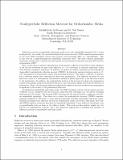| dc.description.abstract | Reflection moveout in azimuthally anisotropic media is not only azimuthally dependent but it is also
nonhyperbolic. As a result, the conventional hyperbolic normal moveout (NMO) equation parameterized
by the exact NMO (stacking) velocity loses accuracy with increasing offset (i.e., spreadlength). This
is true even for a single-homogeneous azimuthally anisotropic layer. The most common azimuthally
anisotropic models used to describe fractured media are the horizontal transverse isotropy (HTI) and the
orthorhombic (ORT).
Here, we introduce an analytic representation for the quartic coefficient of the Taylor’s series expansion
of the two-way traveltime for pure mode reflection (i.e., no conversion) in arbitrary anisotropic media
with arbitrary strength of anisotropy. In addition, we present an analytic expression for the long-spread
(large-offset) nonhyperbolic reflection moveout (NHMO). In this study, special attention is given to Pwave
propagation in orthorhombic media with horizontal interfaces. The quartic coefficient, in general,
has a relatively simple form, especially for shear wave propagation. The reflection moveout for each
shear-wave mode in a homogeneous orthorhombic medium is purely hyperbolic in the direction normal
to the polarization. In addition, the nonhyperbolic portion of the moveout for shear-wave propagation
reaches its maximum along the polarization direction, and it decreases rapidly away from the direction of
polarization. Hence, the anisotropy-induced nonhyperbolic reflection moveout for shear-wave propagation
is significant in the vicinity of the polarization directions.
In multilayered azimuthally anisotropic media, the NMO (stacking) velocity and the quartic moveout
coefficient can be calculated with good accuracy using Dix-type averaging (e.g., the known averaging
equations for VTI media). The interval NMO velocities and the interval quartic coefficients, however,
are azimuthally dependent. This allows us to extend the nonhyperbolic moveout (NHMO) equation,
originally designed for VTI media, to more general horizontally stratified azimuthally anisotropic media.
Numerical examples from reflection moveout in orthorhombic media, the focus of this paper, show that
this NHMO equation accurately describes the azimuthally-dependent P-wave reflection traveltimes, even
on spreadlengths twice as large as the reflector depth. This work provides analytic insight into the
behavior of nonhyperbolic moveout, and it has important applications in modeling and inversion of
reflection moveout in azimuthally anisotropic media. | en_US |
